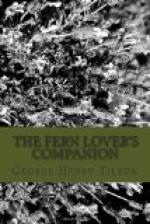(6) TERNATE GRAPE FERN
Botrychium ternatum, var. intermedium
Botrychium obliquum, var. intermedium
Leaf more divided than in obliquum and the numerous segments not so long and pointed, but large, fleshy, ovate or obovate (including var. australe), crenulate, and more or less toothed.
Sandy soil, pastures and open woods. More northerly in its range—New England and New York. Var. rutaefolium. More slender, rarely over six or seven inches high; sterile segment about two inches broad, its divisions few, broadly ovate, the lowest sublunate. The first variety passes insensibly into the second.
[Illustration: Ternate Grape Fern Botrychium ternatum var. intermedium (Reduced)]
[Illustration: Ternate Grape Fern Botrychium ternatum var. intermedium (Two stocks, reduced)]
(7) RATTLESNAKE FERN. Botrychium virginianum
Fronds six inches to two feet high. Sterile segment sessile above the middle of the plant, broadly triangular, thin, membranaceous, ternate. Pinnules lanceolate, deeply pinnatifid; ultimate segments oblong or lanceolate and scarcely or not at all spatulate. Fertile part long-stalked, two to three pinnate, its ultimate segments narrow and thick, nearly opaque in dried specimens. Mature sporangia varying from dark yellow-brown to almost black. Open sporangia close again and are flattened or of a lenticular form. In rich, deciduous woods, rather common and widely distributed.
[Illustration: Rattlesnake Fern. Botrychium virginianum (From Waters’s “Ferns,” Henry Holt & Co.)]
Prince Edward Island, Minnesota, south to Florida and Texas, and north to Newfoundland and Labrador.
Var. gracilis. A form much reduced in size.
Var. LAURENTIANUM. A conspicuous variety having thick and heavy sterile fronds less finely divided than the type, with the segments crowded to overlapping. Pinnules shorter than the type, tending to be ovate, outer segments strongly spatulate. Fertile spike relatively short and stout, strongly paniculate when well developed. Ultimate segments flat, folaceous, one mm. wide. Mostly confined to the limestone district near the Gulf of St. Lawrence, Labrador, Newfoundland, Quebec, Maine, and Michigan.
Var. INTERMEDIUM. Segments of sterile fronds ultimately much spatulate, previously ovate, not overlapping. Segments of fertile fronds ultimately narrowly flattened. (For this and the other varieties see Rhodora of September, 1919.) Nova Scotia, Maine, Vermont, Massachusetts, Connecticut, northern New York, Illinois, and Missouri.
Var. EUROPAEUM. Fertile frond less finely dissected than in type. Ultimate segments more obtuse than in type; has but very slight tendency towards the spatulate form of the two previous varieties. Pinnules lanceolate, strongly decurrent so that the pinnae are merely pinnatifid. In coniferous forests of Canada, and confined to calcareous regions. Quebec, New Brunswick, New Hampshire, Vermont, New York, Ontario, Montana, and British Columbia. Said to be rare even in Europe.




